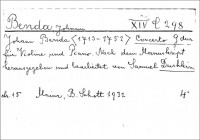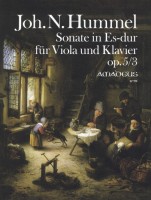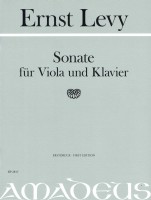
Secrets of music |
Who composed Benda's «Grave»?
Inconsistencies with authorship questions may often be resolved through scientific research. The inquiry of a Music4Viola user triggered a musicological investigation. No stone was left unturned collecting evidence.
Mozart’s first violin concerto, KV 294 a in D major was indeed a finger exercise of Marius Casadesus (1892 – 1981) – the French violinist admitted this truth in 1977, at the age of 84. Before this statement, he had led on the music world for decades. Yehudi Menuhin (1916 – 1999) even made this «discovery» an LP-bestseller in 1934. By the way, Casadesus had further fake works (see bottom left).
It is common knowledge that geniuses become victims of fake works. The phenomenon is also well known from the world of painting. Many a halfway talented composer is able to write music «in such and such a style». Style exercises are taught at college. Whether a high quality fake is convincing, is a question of the criminal energy and marketing.

discovery (Autograph)
Cantata «Wie
schrecklich Herr sind
deine Gerichte»,
Sächsische Academy
of the sciences
In music history, there is indeed a considerable gray zone with works of unclear origin. Musicologists can tell many a tale. Working like detectives, they expose swindlers who are trying to claim all the glory. Often times, no bad intentions can be found, and it remains a mystery, how wrong work attributions happened.
«Surprising discoveries» of music pieces are often found with the death, but not with the living composers, because the latter often remember the works they wrote. I admit that if a work appeared that I would love to have written myself, and who’s authorship is attributed to me, I’d probably remain silent too – as an exception.
Benda who?
Our story: Music4Viola user Reinhard Förster found a recording of the «Grave» for violin and orchestra, by Johann Georg Benda (1713 – 1752) in a version for viola with Yuri Bashmet and Jewgeni Kissin (piano). A magical piece, wonderfully interpreted by two absolute world stars. Förster asked Music4Viola for details. «M4V in-house musicologist» Phillip Schmidt started the investigation in his specialized field: He owns a masters degree in «Erschliessung älterer Musik» (Research of old music) from the Technical University Dresden, has a comprehensive music historical and stylistical knowledge, combined with the mentality of a detective. His research focus lies in the 18th century. He’s an expert of this era, and viola music is his favorite topic.

version is probability the
violin version, but its origin
is doubtful. How it came to
the Benda assignment,
is completely unclear.
Schmidt has repeatedly researched the widely spread family Benda, and has already discovered other doubtful work attributions. He had also looked at the «Grave» before and found two version with different keys (in a minor and e minor), which seems to originate from his violin concerto in D major, respectively G major. Many editors attributed this piece as the middle movement of the violin concerto by said Johann Georg Benda, others suggested it is the middle movement of a violin concerto of his younger brother, Georg Anton Benda (1722 – 1795). Suspiciously, no manuscript or other sources have been found (although diversionary tactics such as «published according to the manuscript» are common), and stylistically, according to Schmidt, the movement doesn’t fit with any of the four Benda brothers of the 18th century (next to J. G. Benda and G. A. Benda, there are also Joseph Benda [1724 – 1804] and Franz Benda [1709 - 1786]), and neither with any of their sons.
Evidence hints towards Russia
Because the piece is mostly known in Russia, Schmidt even suspected Bashmet to have commissioned the work himself, so he could play the world first performance of his «discovery».
Schmidt then found a violin edition of the piece, who’s origin is unknown too. He then called upon a Wikipedia article that supports his argument of a wrong attribution. In a further step, the musicologist finally found the likely main source of all these doubts, in a Russian blog: Using Google Translate, he learned that the piece was probably written by violinist and composer Samuel Dushkin (1891 – 1976), but has been attributed to one of the many Bendas.

from 1932
The first print of the violin concerto has apparently appeared with Schott in 1932, according to the copy of an index card from the card catalog of the Czech music museum in Prague. Dushkin is listed as the «publisher and editor» there.
The evidence suggests that Dushkin is the wrongdoer. However, he cannot be brought to justice anymore, but we’d like to forgive and congratulate him for his wonderful Benda-Grave, sit back and listen to the wonderful performance of the duo Bashmet/Kissin.
These inputs by Phillip Schmidt contain further information on the topic:
1. Johann Christian Bach:
https://www.music4viola.info/werk-info/3/Bach%20J.chr./konzert-c-moll-fuer-bratsche-und-orchester?l=en
2. Carl Philipp Emanuel Bach:
https://www.music4viola.info/werk-info/10/Bach%20C.ph.e/konzert-d-dur-fuer-violine-bratsche-und-klavier?l=en
3. Georg Friedrich Händel:
https://www.music4viola.info/werk-info/9/H%C3%A4ndel%20G.f./konzert-h-moll-fuer-bratsche-und-orchester?l=en
4. Beatrice Mattei:
https://www.music4viola.info/werk-info/1/Mattei%20B./sonata-c-dur-fuer-bratsche-und-cembalo?l=en
5. Henry Eccles:
https://www.music4viola.info/werk-info/1/Eccles%20H./sonate-g-moll-op-1-nr-11-fuer-bratsche-und-klavier?l=en
More interesting links to "Grave":
1. J.J.Benda «Grave» auf Youtube:
https://www.youtube.com/watch?v=J2tEwRKOnHs
2. Benda - Grave - Viola de Arco (Bashmet e os Solistas de Moscou) auf Youtube:
https://www.youtube.com/watch?v=bWlenz_s0tc
en.wikipedia.org/wiki/Johann_Georg_Benda
Two, it takes great talent to create a work in the classical/baroque style that is convincing to audiences. He is utterly wrong to put down Casadesus that way.

This blog article is written by Niklaus Rüegg, graduate of the Zurich International Opera Studio, graduate of the Basel Opera Academy, twice winner of the Migros Gifted Scholarship, numerous engagements in opera, operetta, musicals and concerts in Switzerland and abroad.
Rüegg has also been working as a music journalist for ten years and is responsible for the association pages of the VMS (Verband Musikschulen Schweiz) in the Schweizer Musikzeitung. As a young man, Niklaus Rüegg had played the violin and viola.
|
New sheet music editions |

Film music for string trio by Daniel Hauptmann

(1778–1837)
Sonata in E flat major, op. 5/3, for viola and piano, edited by Bernhard Päuler

Sonata for viola and piano,
published byTimon Altweg

Adagio and Allegro, op. 70, for viola and piano, edited by Thomas Riebl
|
This might also be of interest to you |
Georg Philipp Telemann was one of the most prominent composers of the Baroque era. He introduced innovative thinking into the world of music and changed the music of the early 18th century significantly.
» to the blog
|
Viola news letter |
 Do you don't want to miss any news regarding viola anymore? Our monthly viola news letter will keep you informed.
Do you don't want to miss any news regarding viola anymore? Our monthly viola news letter will keep you informed.» Subscribe to our viola letter for free
|
|
 Visit and like us on Facebook.
Visit and like us on Facebook.» Music4Viola on Facebook
